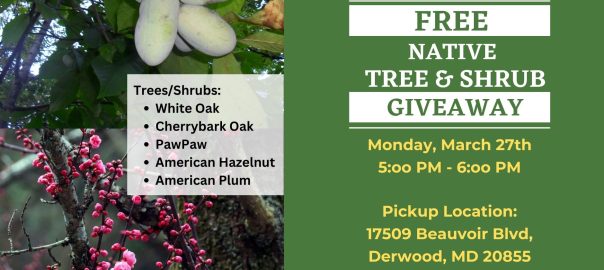Mon, Mar. 27, 2023, 5-6pm
Pick Up Location: 17509 Beauvoir Blvd, Derwood, MD 20855
The Mill Creek Towne Garden Club is pleased to offer FREE native trees and shrubs provided to us by the Maryland Department of Natural Resources.
We are giving away 100 native trees and shrubs starting at 5PM and ending at 6PM on Monday, March 27th. First come, first serve.
Trees/Shrubs: White Oak, Cherrybark Oak, PawPaw, American Hazelnut, and American Plum
The trees and shrubs will be available for pick up at 17509 Beauvoir Blvd, Derwood, MD 20855. Please limit your selection to two plants per household. If you want more than two, please provide your name and contact information so we can contact you. The trees come bareroot – they need to be planted as soon as possible and you will need to provide deer protection unless they are inside a fenced area that the deer do not frequent. Please bring damp newspaper to wrap the roots up until they are ready for planting.
For more detailed guidance on planting and caring for bare root trees visit: https://dnr.maryland.gov/forests/Documents/Planting-Guide-Brochure.pdf
These plants are free to the public, but we do welcome donations to the Club to help us continue to beautify our neighborhood and provide quality programming. To donate please visit https://www.mctgardenclub.org/donations/ and consider joining the Mill Creek Towne Garden Club!
For questions, please use the contact form below. Thank you!
White Oak (Quercus alba)
The majestic white oak is Maryland’s official state tree. It prefersmoist to dry woodland areas. The white oak is a large tree that grows to a height of 60 to 100 feet, with a spread of 50 to 80 feet. The trunk is typically 2 to 4 feet in diameter. Grown trees in open areas have widely spreading, rigid, horizontal branches which form a broad, round-topped crown.
White oak grows in moist as well as dry soils, but prefers rich, well-drained uplands, slopes, and terraces. Mature trees occur in full sun to shade, but young white oaks thrive only in full sun. They cannot tolerate shade and therefore do not regenerate in densely shaded forests.
Cherrybark Oak (Quercus pagoda)
The cherrybark oak is one of the most highly valued red oaks in the southern United States. Cherrybark oak is a medium to large tree that grows up to 100 feet tall. It is larger and better formed than southern red oak and commonly grows on more moist sites. It grows best in moist, well-drained bottomland sites, but is adaptable to drier sites in full sun to partial shade. Useful as a shade tree in large areas, street tree or naturalized spaces.
Pawpaw (Asimina triloba)
A shrub or small tree that tolerates shade, pawpaw produces a fruit that is readily eaten by wildlife and humans. It grows to a height 15 to 30 feet, with a spread of 15 to 30 feet, and prefers full sun to part shade and moist fertile soils. Often spreads by root suckers to form colonies or thickets.
American Hazelnut (Corylus americana)
The American Filbert is a multi-stemmed shrub with a rounded top and an open, often wide-spreading base. The American hazelnut grows to a height of 15–18 feet and a spread of 10–12 feet at maturity. Full sun and partial shade are best for this shrub, meaning it prefers a minimum of 4 hours of direct, unfiltered sunlight each day. Because of its size, it adapts well to naturalizing and other nonformal areas. It bears annual, abundant crops of small, sweet tasting nuts. It will bear in 2-3 years after planting. The nuts are easy to crack and drop free of the husk when mature. (Plant multiple trees with the same flowering time to ensure pollination) (zone 4-9).
American Plum (Prunus americana)
The American plum is a small tree that is native throughout much of the central United States. It grows to the height of 10 – 20 feet, with a spread of 15 – 25 feet. It prefers full to partial sun/shade and clay, loamy, moist, well drained, slightly acidic soil. It produces 1”, reddish-purple plums that are best suited for jams or jellies. Though it does grow fruit, this tree is typically planted for ornamental and wildlife value.
